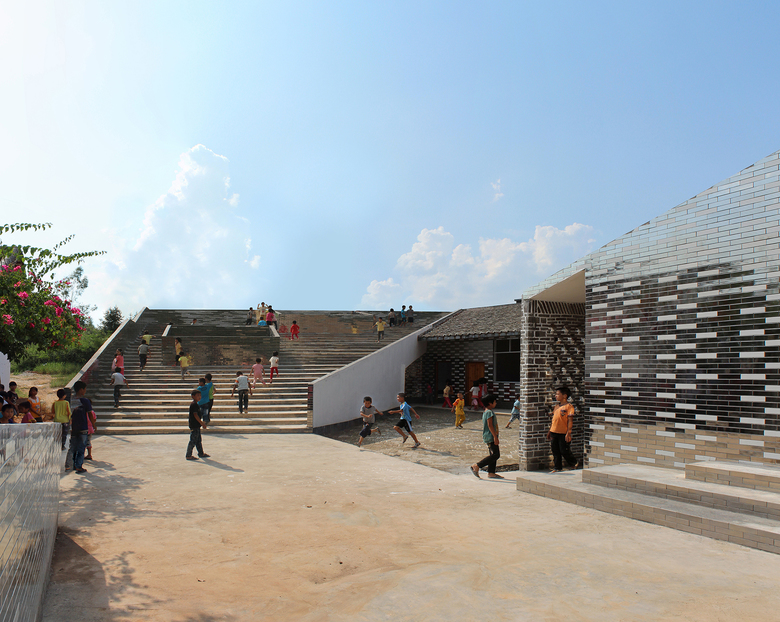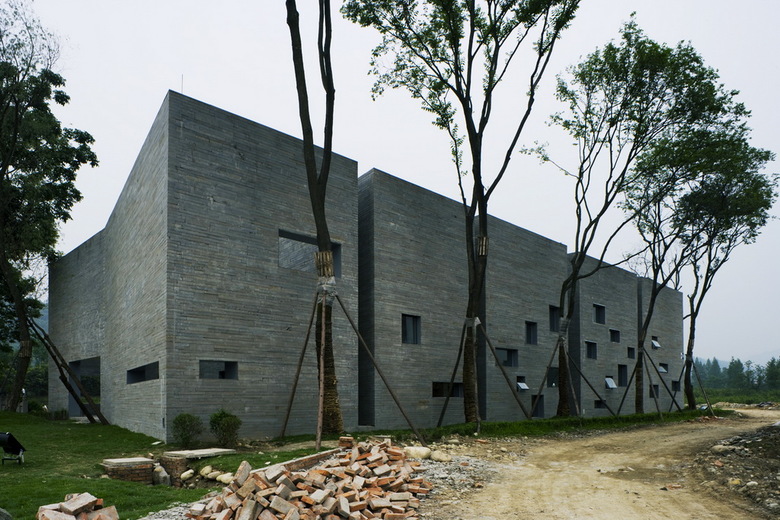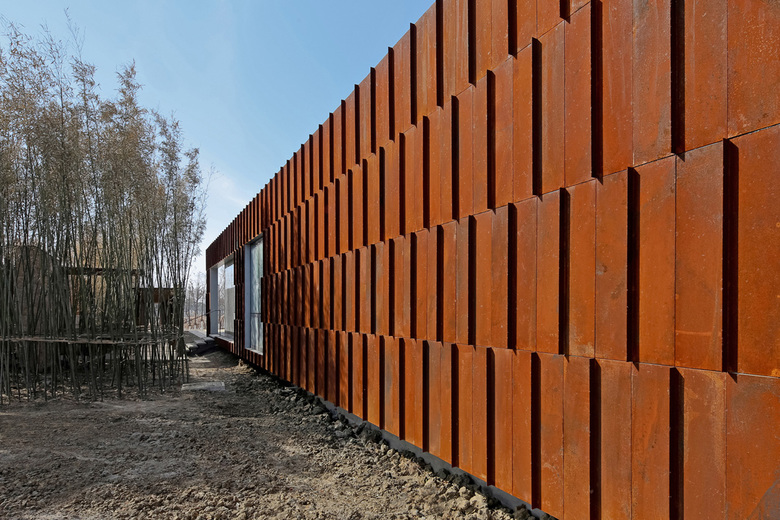China's "Un-Weird" Architecture
John Hill
27. October 2014
Vector Architects: Eco-Farm Series – Visitor Center (Photo: Shengliang Su)
In response to Chinese leader Xi Jinping's call for an end to "weird architecture" in China, we combed through the profiles on the Chinese-Architects platform of World-Architects to highlight some firms working in a different vein.
Citing projects such as OMA's CCTV Headquarters in Beijing, humorously nicknamed "Big Pants" by the Chinese, The China Post stated on October 16 that Xi Jinping "reportedly called for an end to 'weird architecture' in a country that has seen a huge construction boom." Since his speech at a literary symposium, the international architecture media has jumped on his words, often using it as an excuse to display some eye candy of "weird" architecture in China, much of it created by architects from overseas. Seemingly addressing national character in cultural expression in light of Western influence, Xi Jinping stated, "We should not tailor Chinese aesthetics to Western theories, and more importantly, we cannot allow business standards to replace art standards."
While it remains to be seen if Xi Jinping's speech will lead to the opposition of projects branded "weird" in the future, or if developers asking for novel designs will take his words seriously, architecture that balances Chinese tradition with Western influences can be found more and more each day. Wang Shu's 2012 Pritzker Architecture Prize brought attention to an approach that takes the local culture into account, instead of fostering novel forms and ideas upon a context. Here, with the help of Chinese-Architects curator Eduard Kögel, we highlight Wang Shu's Amateur Architecture Studio and seven more Chinese firms producing "un-weird" architecture today. Click on the title links to see the office profiles of the respective firms.
Amateur Architecture Studio
Partners: Wang Shu and Lu Wenyu
Founded: 1998
Office Profile
In announcing Wang Shu as the recipient of the 2012 Pritzker Architecture Prize, the jury said, "[China's] urbanization, like urbanization around the world, needs to be in harmony with local needs and culture. China’s unprecedented opportunities for urban planning and design will want to be in harmony with both its long and unique traditions of the past and with its future needs for sustainable development." Clearly, this statement sets the architecture of Wang Shu and his wife and partner Lu Wenyu in opposition to much of the "weird" architecture found in his home country. In acknowledging his output with the prize considered architecture's highest honor, the jury embraced the Amateur Architecture Studio philosophy: "Any building activity without comprehensive thoughtfulness will be insignificant."
Amateur Architecture Studio: Ningbo History Museum (Photo: Lv Hengzhong)
Amateur Architecture Studio: Ningbo Tengtou Pavillion (Photo: Lu Wenyu)
Amateur Architecture Studio: China Art Academy, new campus of Xiangshan School (Photo: Lv Hengzhong)
AZL Atelier Zhanglei
Owner: Zhang Lei
Founded: 2009
Office Profile
The often brick and gable forms of AZL's buildings spring from a philosophy that counters the trends Xi Jinping referred to; Zhang Lei says: "The basic principle that the design should be concerned about is solving problems with the most reasonable and direct way of construction, responding to requirements of adaptability with ordinary materials and construction methods as well as trying to find out the potential visual expressiveness from among ordinary materials. This should further become a work-strategy applicable to the large-scale construction in the rapid development of Chinese urbanization today, as well as benefit the control of consumptions of limited human resources."
AZL Atelier Zhanglei: Three Courtyard Community Center (Photo: Iwan Baan)
AZL Atelier Zhanglei: Brick House
AZL Atelier Zhanglei: Slit House
Rural Urban Framework
Partners: John Lin and Joshua Bolchover
Founded: 2006
Office Profile
The architectural design and research office of John Bolchover and John Lin is a non-profit organization based at the University of Hong Kong focused on rural development projects. Since many of their projects are realized in places undergoing urbanization, they "believe that the future of an area is dependent on the uniqueness of its present condition, [and they] strategically intervene to ensure that [the] projects and the communities in which they are located can adapt to future change." Their objectives are three-fold: "To make architecture that actively contributes to the future transformation of the areas in which they are located; to make architecture that influences policy makers in their approach to the design of schools, community facilities and other public buildings; and to find new models of rural development that enables the social, economic and spatial evolution of villages that resists the overwhelming process of urbanization."
Rural Urban Framework: Tongjiang Recycled Brick School
Rural Urban Framework: Mulan Primary School
Rural Urban Framework: Lingzidi Bridge
Scenic Architecture
Owner: Zhu Xiaofeng
Founded: 2004
Office Profile
Zhu Xiaofeng's design philosophy explicitly goes against the "international trend of formalism" that Xi Jinping alludes to. The architect describes his philosophy: "The spirit of architecture exists in how people perceive the basics of nature and living. Rather than certain style, it is the emotion and logic of space, light, material and human activity what is vital in our design. This means an ancient stone and a digital structure are equally inspiring in our journey of exploring wisdom and poetry. At the same time, we dedicate our energy to explore strategies of transforming contemporary urban and social dynamics into operable design languages. We believe that this is an experimental way to keep architecture fresh and away from an international trend of formalism."
Scenic Architecture: Zhujiajiao Museum of Humanities & Arts (Photo: Iwan Baan)
Scenic Architecture: Community Pavilion at Jintao Village
Scenic Architecture: Sunrise Plaza
standardarchitecture
Principals: Zhang Ke, Zhang Hong and Claudia Taborda
Founded: 2001
Office Profile
The firm that Zhang Ke founded "consciously distance themselves from many of the other 'typical' young generation architects who are swallowed by a trend of noise making." They further describe that "the office remain[s] detached in a time of media frenzy and their focus is consistently positioned on the realization of urban visions and ideas." Further, "their buildings and landscapes are always rooted in the historic and cultural settings with a degree of intellectual debate."
standardarchitecture: Qingcheng Mountain Stone Courtyard (Photo: Chen Su)
standardarchitecture: Niyang River Visitor Center (Photo: Chen Su)
standardarchitecture: Tibet Namchabawa Visitor Center (Photo: Chen Su)
TAO (Trace Architecture Office)
Owner: Hua Li
Founded: 2009
Office Profile
Similar to the architects described above and below, Hua Li positions his work relative to the "weird" architecture getting the bulk of the media's and public's attention: "Being critical at contemporary architecture as an obsession to fashionable forms in the context of media driven globalized consumerism, TAO visions architecture and its environment as an inseparable whole [where] architecture is always a part of its surroundings rather than an isolated object." Further, "TAO aims to make architecture deeply rooted in its social and environmental context with respect of local condition. The sense of place, response to climate, efficient use of local resource, appropriate material and construction method, such essential issues are always explored in every TAO project responding to its specific situation."
TAO: Museum of Handcraft Paper (Photo: Shu He, Hua Li)
TAO: Riverside Clubhouse - Folded Farnsworth (Photo: Yao Li)
TAO: Wuyishan Bamboo Raft Factory (Photo: Hua Li)
TM Studio
Owner: Tong Ming
Founded: 2000
Office Profile
According to its design philosophy, and evidenced in their work, Tong Ming's TM Studio takes the relationship between old and new to be of the utmost importance: "Within a background of drastic development and industrialization of China, TM Studio explores the work to integrate the disconnected things in a continually changing world, such as present and history, imagination and reality, events and environment. It is a kind of work that is engaged with what is there, to use what exists as a starting point, to bring about idealization through analysis and to reveal the unused potential of the reality, to apply transformation and integration as a path that lead to new insight and expressions."
TM Studio: Suquan Yuan
TM Studio: Park Block Renovation
TM Studio: Zhou Chunya Art Academy (Photo: Lu Hengzhong)
Vector Architects
Owner: Gong Dong
Founded: 2008
Office Profile
Logic and simplicity are guiding rules for Dong Gong, taking precedence over architectural self-consciousness or a blind chase after trends of form and surface. Per the architect: "Vector Architects pursues the fundamental simplicity and logical clarity through the everyday thinking and working process. We initiate the design process with "Identifying the question", based on the consideration of the program and the clients need, and the understanding of social, cultural, historic, climate, and urban context of each project. We believe in simple solution as a result of a comprehensive design study progress."
























